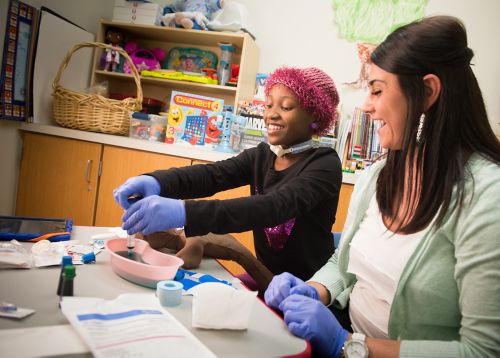Art therapy is a form of expressive therapy that uses creative activities such as drawing, painting, or sculpting to improve physical, mental, and emotional well-being.
Art therapy is often used to reduce stress or anxiety, explore complex feelings, manage side effects, and improve quality of life.
Benefits of art therapy
Art therapy may be used to:
- Explore and express emotions and feelings
- Build relationships and provide opportunities for social connections
- Improve communication and social skills
- Enhance cognitive function such as reasoning, memory, attention, and language
- Improve sensory and motor skills
- Increase self-confidence and self-esteem
- Reduce stress and anxiety
- Improve coping skills
- Increase sense of control
- Provide distraction
It can be hard for children to communicate their thoughts and emotions. Art therapy can provide a way for children to express themselves. Children are naturally creative, and painting a picture may be easier than talking about complex or scary topics. Creating artwork may also increase a child’s sense of control at a time when so much is out of control.
Children are naturally creative. Painting a picture may be easier than talking about complex or scary topics. Creating artwork may also increase a child’s sense of control at a time when so much is out of control.
Art therapy may help children process struggles or find a positive way to look at their situations. For example, drawing a picture of oneself as a superhero may help a child feel a sense of strength and empowerment.
Art therapy may allow children to understand fears, insecurities, or stress. For example, a child may draw a picture of playing with friends, which the art therapist may use as a starting point to discuss feelings of loneliness.
Finding art therapy services
Children should be encouraged to engage in art and creative play as part of their regular activities. Art therapy for children with serious illnesses may be offered as part of child life, rehabilitation, or mental health services in hospitals and clinics. Art therapy may also be offered in schools, community centers, and private clinics.
Art therapy is facilitated by a professional art therapist. Providers who specialize in art therapy have training in art, child development, and psychology.
An art therapist provides a safe, creative environment for children and teens to express themselves in group or one-on-one settings. An art therapist may recommend specific techniques such as painting or sculpting, or the therapist may allow patients to choose the method that they would like to use.
Art therapists are trained to recognize symbols and metaphors often expressed through the creative process. Art therapy can improve communication and connections among family members by providing a shared activity.
In some cases, families may use art therapy activities to make memories and keepsakes during end-of-life care.
Science of art therapy
The use of art therapy has been studied in patients with different medical conditions.
For example, in children with cancer, there is evidence that art therapy reduces anxiety, depression, and pain and improves quality of life. Results show that children who participate in art therapy may better express underlying emotions, develop more effective coping skills, and experience fewer adverse side effects. Art therapy also helps children communicate with caregivers which can lead to improved care and better medical outcomes.
Art therapy is a child-friendly complementary therapy that can be an important component of care during a serious illness.
For more information on the professional practice of art therapy, visit the American Art Therapy Association.






